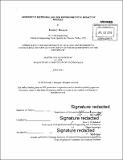| dc.contributor.advisor | John A. Ochsendorf. | en_US |
| dc.contributor.author | Bianquis, Rosalie J. (Rosalie Julia) | en_US |
| dc.contributor.other | Massachusetts Institute of Technology. Department of Civil and Environmental Engineering. | en_US |
| dc.date.accessioned | 2015-10-30T18:58:03Z | |
| dc.date.available | 2015-10-30T18:58:03Z | |
| dc.date.copyright | 2015 | en_US |
| dc.date.issued | 2015 | en_US |
| dc.identifier.uri | http://hdl.handle.net/1721.1/99586 | |
| dc.description | Thesis: M. Eng., Massachusetts Institute of Technology, Department of Civil and Environmental Engineering, 2015. | en_US |
| dc.description | Cataloged from PDF version of thesis. Title appears above thesis title on Abstract page: Assessment Methodology for Environmental Impact of Bridges - 2015. | en_US |
| dc.description | Includes bibliographical references (pages 86-87). | en_US |
| dc.description.abstract | Residential and commercial buildings and transportation represent 21% of the global greenhouse gas emissions in the world. In the United States, this percentile goes up to 38% of the greenhouse gas emissions of the country. Since the structures account for the highest material weight in buildings, any reduction in the emissions due to structures (their construction, operation, maintenance, and end of life) can have a real impact on the total emissions of greenhouse gases in the world. Many rating systems have been established to evaluate the performance of buildings and their environmental impact. However, less work has been done for bridges. The existing ratings system for buildings cannot yet be adapted to bridges because of the different use of these structures. Indeed, while a building would have important emissions during the operation phase, a bridge would have practically none. Moreover, the bridge creates a shorter path for cars to travel and therefore it can actually reduce some emissions due to the cars and other vehicles. Many other differences show that to evaluate the environmental impact of bridges and their part in the global warming, a new set of studies needs to be conducted. This thesis will develop a methodology to evaluate the environmental impact of bridges, mainly focusing on road bridges: first, by developing a methodology assessing embodied carbon of bridges instead of buildings, second by applying this method to fifteen footbridges and six road bridges, and third by including traffic, operation and maintenance into carbon accounting and conducting three cases studies. The results show that the footbridges emit on average 419 kgco2e/m 2. Road bridges emit on average 1347 kgco2e/m2 for road bridges with a length under 1000m and 3446kgco2r/m2 for the others. Finally, it shows how important the operation phase is compared to the maintenance phase. | en_US |
| dc.description.statementofresponsibility | by Rosalie J. Bianquis. | en_US |
| dc.format.extent | 87 pages | en_US |
| dc.language.iso | eng | en_US |
| dc.publisher | Massachusetts Institute of Technology | en_US |
| dc.rights | M.I.T. theses are protected by copyright. They may be viewed from this source for any purpose, but reproduction or distribution in any format is prohibited without written permission. See provided URL for inquiries about permission. | en_US |
| dc.rights.uri | http://dspace.mit.edu/handle/1721.1/7582 | en_US |
| dc.subject | Civil and Environmental Engineering. | en_US |
| dc.title | Assessment methodology for the environmental impact of bridges | en_US |
| dc.title.alternative | Assessment Methodology for Environmental Impact of Bridges - 2015 | en_US |
| dc.type | Thesis | en_US |
| dc.description.degree | M. Eng. | en_US |
| dc.contributor.department | Massachusetts Institute of Technology. Department of Civil and Environmental Engineering | |
| dc.identifier.oclc | 925474204 | en_US |
